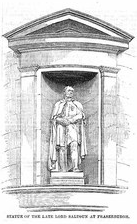
Fraserburgh is a town in Aberdeenshire, Scotland with a population recorded in the 2011 Census at 13,100. It lies at the far northeast corner of Aberdeenshire, about 40 miles (64 km) north of Aberdeen, and 17 miles (27 km) north of Peterhead. It is the biggest shellfish port in Scotland and one of the largest in Europe, landing over 5,450 tonnes in 2016. Fraserburgh is also a major port for white and pelagic fish.

Lord Saltoun, of Abernethy, is a title in the Peerage of Scotland. It was created in 1445 for Sir Lawrence Abernethy. The title remained in the Abernethy family until the death in 1669 of his descendant the tenth Lady Saltoun. She was succeeded by her cousin Alexander Fraser, the eleventh Lord. He was the son of Alexander Fraser and Margaret Abernethy, daughter of the seventh Lord Saltoun. The title has remained in the Frasers of Philorth family ever since.

Banff and Buchan is a committee area of the Aberdeenshire Council, Scotland. It has a population of 35,742. Fishing and agriculture are important industries, together with associated processing and service activity.

Marjorie Flora Fraser, 21st Lady Saltoun is a Scottish peer. Until her retirement on 12 December 2014, she was the only holder of a lordship of Parliament who had a seat in the House of Lords as an elected hereditary peer. Lady Saltoun is the Chief of the Name and Arms of Clan Fraser since 1 May 1984, by decree of the Court of the Lord Lyon. She is also the head of the Scottish lowland family the Frasers of Philorth.

Kinnaird Head is a headland projecting into the North Sea, within the town of Fraserburgh, Aberdeenshire, on the east coast of Scotland. The 16th-century Kinnaird Castle was converted in 1787 for use as the Kinnaird Head Lighthouse, the first lighthouse in Scotland to be lit by the Commissioners of Northern Lights. Kinnaird Castle and the nearby Wine Tower were described by W. Douglas Simpson as two of the nine castles of the Knuckle, referring to the rocky headland of north-east Aberdeenshire. The lighthouse is a category A listed building. and the Wine Tower. is a scheduled monument. The buildings around the base of the lighthouse are the work of Robert Stevenson.

Clan Fraser is a Scottish clan of the Scottish Lowlands. It is not to be confused with the Clan Fraser of Lovat who are a separate Scottish clan of the Scottish Highlands. Both clans have their own separate chief, both of whom are officially recognized by the Standing Council of Scottish Chiefs.

Peterhead is a town in Aberdeenshire, Scotland. It is Aberdeenshire's biggest settlement, with a population of 18,537 at the 2011 Census. It is the biggest fishing port in the United Kingdom for total landings by UK vessels, according to a 2019 survey.
The Frasers of Philorth are a Scottish lowland family, originally from the Anjou region of France. Castle Fraser, their family seat, is in Sauchen, Aberdeenshire, Scotland. Since the time of Alexander Fraser, 11th Lord Saltoun, the heads of the Philorth family are the Lords Saltoun. The current head of the Frasers of Philorth is Flora Fraser, 21st Lady Saltoun, who is Chief of the Name and Arms of Clan Fraser since 1 May 1984, by decree of the Court of the Lord Lyon. The family's arms are "azure, three cinquefoils argent"—three silver strawberry flowers on a field of blue. The heraldic cinquefoil is a stylized five-point leaf; the cinquefoils which appear on the Fraser of Philorth coat-of-arms are specifically strawberry flowers. Only the Lady or Lord Saltoun is permitted to display these arms plain and undifferenced.
Alexander Fraser, 11th Lord Saltoun, was a Scottish peer and the 10th Laird of Philorth.

Cairnbulg Castle is a z-plan castle situated in Cairnbulg, Aberdeenshire, Scotland. It was described by W. Douglas Simpson as one of the nine castles of the Knuckle, referring to the rocky headland of north-east Aberdeenshire. It stands by the River Philorth and was originally known as Philorth Castle. The 17th-century Philorth Castle, an L-plan house consisting of a sizeable crow-stepped block, was demolished after a fire in 1915.
William Fraser, 12th Lord Saltoun, was a Scottish peer and the 11th Laird of Philorth.
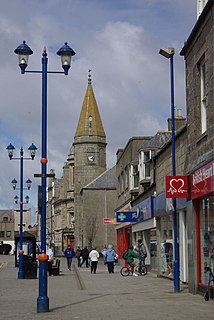
Fraserburgh Old Parish Church is a congregation of the Church of Scotland in Fraserburgh, Aberdeenshire. The present building was erected in 1803 at the head of the High Street, on the site of a 16th-century church. The church is a category B listed building.
Charles Ferm, Ferme, Farholme or Fairholm (ca.1566–1617), was a leading campaigning Presbyterian minister in the Church of Scotland, and the Principal of Fraserburgh University, Scotland.
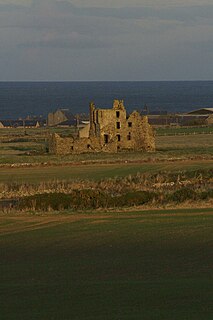
Pittulie Castle is an oblong tower house probably dating from 1596, half a mile from Pitsligo Castle, Rosehearty, Aberdeenshire, Scotland. It is a scheduled monument. Built by the Frasers of Philorth, it was described by W. Douglas Simpson as one of the nine castles of the Knuckle, referring to the rocky headland of north-east Aberdeenshire.

Fraserburgh Academy is a secondary school in Fraserburgh, Aberdeenshire. It is one of seventeen schools run by Aberdeenshire Council. The current school building was opened in 1962 by H.R.H The Princess Margaret.
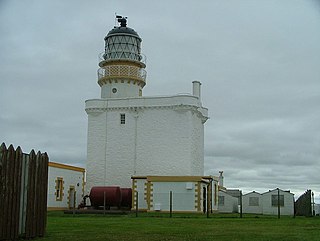
Alexander Fraser of Philorth was a Scottish landowner and founder of Fraserburgh.

Strichen Town House is a municipal structure in High Street, Strichen, Aberdeenshire, Scotland. The building, which was the meeting place of Strichen Parish Council, is a Category A listed building.
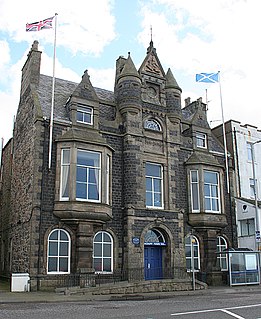
Macduff Town Hall is a municipal building in Shore Street, Macduff, Aberdeenshire, Scotland. The structure, which was the meeting place of Macduff Burgh Council, is a Category B listed building.
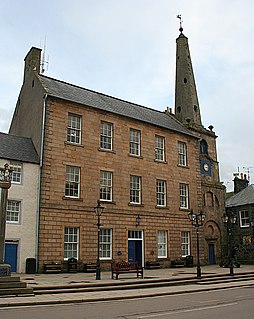
Banff Town House is a municipal building in Low Street, Banff, Aberdeenshire, Scotland. The building, which is used as a customer service point and job centre, forms part of a complex consisting of a steeple, completed in 1767, which is a Category A listed building, and a town house, completed in 1797, which is also a Category A listed building.
The Fraserburgh and St Combs Light Railway was a short railway branch line built in Aberdeenshire, Scotland, to serve fishing harbours. It was built by the Great North of Scotland Railway (GNoSR), and it connected with the GNoSR at Fraserburgh.


